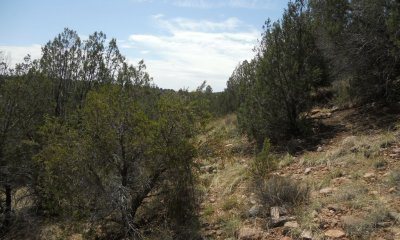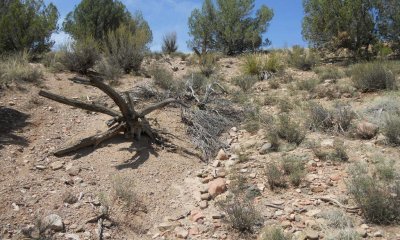
Limy Hills 16-20" p.z.
Scenario model
Current ecosystem state
Select a state
Management practices/drivers
Select a transition or restoration pathway
- Transition T1a More details
- Transition T1b More details
- Restoration pathway R2a More details
- Transition T2a More details
- Transition T2b More details
- Restoration pathway R3b More details
- Restoration pathway R3a More details
- Transition T3a More details
-
No transition or restoration pathway between the selected states has been described
Target ecosystem state
Select a state
Description
Two dominant communities cycle in this state with fire or absence of fire being the main driver between communities. One seed or red berry juniper is the dominant tree; Bear grass, mint bush lippia, and Stansbury cliffrose are the dominant shrubs; black grama and sideoats grama are the dominant grass species. Wildfire is a natural component in this plant community.
Black grama populations have variable responses to fire. It has poor seed viability and regenerates primarily by vegetative stolons. The US Forest Service Fire Effects Information System summarizes research on black grama by Allen (1996, 1998), Cable (1965), Gosz (1996), and Humprey (1950), acknowledging the susceptibility of black grama to fire but also the good post fire recovery if the stand is healthy before fire and there is adequate precipitation the 2 years following fire. Black grama populations have persisted where they have experienced periodic fire in the northern part of White Sands Missile Range where herbivory is very light (Dave Anderson, personal communication 1998). Minimal to moderate herbivory maintaining high plant vigor is likely highly important in black grama’s response to fire.
Fire return intervals have not been studied in detail on this ecological site but are likely similar or possibly slightly longer to that suggested by Robinett (2005) on adjacent Volcanic derived soils that support a mixed grass/shrub-tree plant community with return intervals ranging from 10-15 years. This assumption is based on a slightly longer recovery due to vegetative reproduction but the nearly continuous perennial grass herbaceous understory that can develop in a 15-20 year period that is very conducive to fire spread.
Submodel
Description
Herbaceous production is reduced to approximately 100-200 lbs/ac. Tree canopy is approximately 2-5% and shrub canopy is approximately 5-10%, levels similar to the reference plant community.
Submodel
Description
Juniper has increased in the absence of fire to 40-50% canopy. Pinyon is less prevalent with 1-5% canopy. Two major communities occur in this state that have different amounts of herbaceous production.
Submodel
Mechanism
Continuous high intensity herbivory, generally at close distances to water, reduces the vigor of perennial grass species. Plant densities are usually less than 1 plant per square yard.
Mechanism
Juniper plants germinate and grow to maturity in the absence of fire. The dominant perennial grass plants maintain themselves at densities of 4-7 plants per square yard despite the presence of high juniper canopy cover.
Mechanism
The ability to achieve this restoration pathway is uncertain. The application of prescribed grazing and seeding of sideoats grama is the only likely restoration. This is due to black grama’s poor seed viability and the long time periods it would take for vegetative recovery of the site by this species.
Mechanism
Juniper plants germinate and grow to maturity in the absence of fire. Rill erosion has not become severe on the site and perennial grass plants maintain themselves at low densities in the presence of high juniper canopy cover.
Mechanism
Continuous heavy livestock herbivory further deduces the vigor of the dominant grass species and high intensity rains result in severe rill formation or existing rills developing into gullies.
Mechanism
The ability to achieve this restoration pathway is uncertain. Herbaceous plants are present in relatively high amounts (4-7 per square yard) that make re-colonization of the site more favorable. Prescribed fire should only be applied after an average to above average summer monsoon season followed by average to above average winter/spring precipitation. The average to above average winter moisture is highly critical to ensure root systems of black grama are well hydrated and have the best possible chance of surviving fire.
Mechanism
The ability to achieve this restoration pathway is uncertain. The application of prescribed grazing and seeding of sideoats grama is the only likely restoration for the herbaceous component of the community. This is due to black grama’s poor seed viability and the long time periods it would take for vegetative recovery of the site by this species. Brush management by hand sawing of juniper species is the only practical alternative for reducing juniper dominance. These soils are highly susceptible to erosion even when disturbed by light equipment. Shearing with bobcat type loaders should not be attempted even on lower slope areas.
Model keys
Briefcase
Add ecological sites and Major Land Resource Areas to your briefcase by clicking on the briefcase (![]() ) icon wherever it occurs. Drag and drop items to reorder. Cookies are used to store briefcase items between browsing sessions. Because of this, the number of items that can be added to your briefcase is limited, and briefcase items added on one device and browser cannot be accessed from another device or browser. Users who do not wish to place cookies on their devices should not use the briefcase tool. Briefcase cookies serve no other purpose than described here and are deleted whenever browsing history is cleared.
) icon wherever it occurs. Drag and drop items to reorder. Cookies are used to store briefcase items between browsing sessions. Because of this, the number of items that can be added to your briefcase is limited, and briefcase items added on one device and browser cannot be accessed from another device or browser. Users who do not wish to place cookies on their devices should not use the briefcase tool. Briefcase cookies serve no other purpose than described here and are deleted whenever browsing history is cleared.
Ecological sites
Major Land Resource Areas
The Ecosystem Dynamics Interpretive Tool is an information system framework developed by the USDA-ARS Jornada Experimental Range, USDA Natural Resources Conservation Service, and New Mexico State University.








